50 Years Ago: Apollo 16 Returns to the Launch Pad
In February 1972, following repairs to their spacecraft, Apollo 16 astronauts Commander John W. Young, Command Module Pilot Thomas K. Mattingly, and Lunar Module Pilot Charles M. Duke watched their Saturn V rocket roll back out to its launch pad at NASA’s Kennedy Space Center in Florida in preparation for the planned April 16 launch. Along with backups Fred W. Haise, Stuart A. Roosa, and Edgar D. Mitchell, they continued training for the fifth Moon landing, a planned 12-day mission to the Descartes site in the lunar highlands. The astronauts received extensive geology training, including their final field trip; rehearsed the spacewalks planned for their mission, including deploying the scientific instruments and driving the Lunar Roving Vehicle (LRV); and practiced other aspects of their flight in mission simulators.
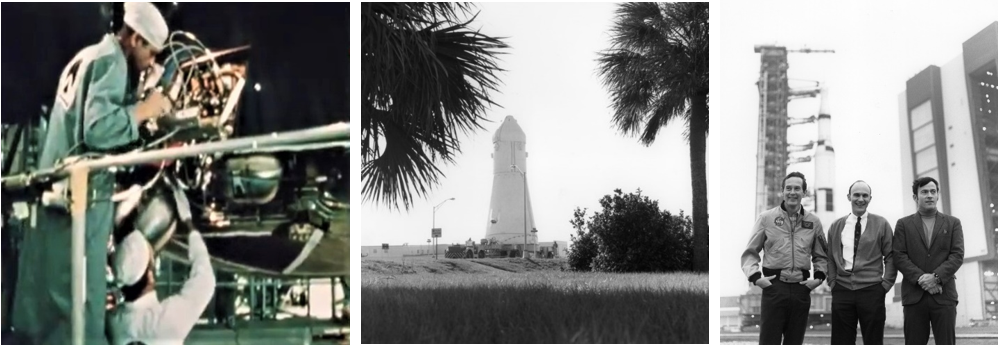
Left: Technicians in the Manned Spacecraft Operations Building (MSOB) at NASA’s Kennedy Space Center in Florida replace reaction control system tanks in Apollo 16’s Command Module. Middle: Ground crews transport the Apollo 16 spacecraft from the MSOB to the Vehicle Assembly Building (VAB) for restacking onto the Saturn V rocket. Right: Apollo 16 astronauts Charles M. Duke, Thomas K. Mattingly, and John W. Young in front of their Saturn V rocket as it rolls out of the VAB. Credits: NASA
On Jan. 25, during a test at Kennedy’s Launch Pad 39A, workers accidentally over-pressurized a fuel tank in the Command Module’s reaction control system. The resulting damage required a replacement of the tank, an activity that could not be performed at the pad and, two days later, the entire Saturn V rolled back to the Vehicle Assembly Building (VAB). Once in the VAB, workers removed the spacecraft from the rocket and trucked it to the Manned Spacecraft Operations Building (MSOB), where technicians de-mated the Command Module from the Service Module, removed its heat shield, and replaced the damaged fuel tank. The repair completed, workers in the MSOB reassembled the spacecraft, towed it back to the VAB, and stacked it on top of its Saturn V rocket. On a cold and rainy Feb. 9, Young, Mattingly, and Duke watched their rocket slowly roll out of the VAB atop its crawler transporter and make its way back to Launch Pad 39A.

Left: Apollo 16 astronaut John W. Young works near the Explorer, a training version of the Lunar Roving Vehicle, during the February 1972 geology field trip to Boulder City, Nevada. Middle: Duke, left, and Young practice documenting rock samples. Right: Young, left, and Duke during one of the training traverses. Credits: NASA

Apollo 16 backup astronauts Fred W. Haise, in a white hat, and Edgar D. Mitchell during the February 1972 geology field trip to Boulder City, Nevada. Credits: NASA
For their final geology field trip, Young, Duke, Haise, and Mitchell traveled to Boulder City, Nevada, from Feb. 16-18, along with a team of geologists. They completed two training traverses, including driving a training version of the LRV, called Explorer, to simulate the planned second and third lunar-surface excursions. The prime personnel who would support the spacewalks during the mission were situated in the Science Support Rooms in the Mission Control Center (MCC) at the Manned Spacecraft Center (MSC) in Houston, now NASA’s Johnson Space Center, and in direct communication with the crew.
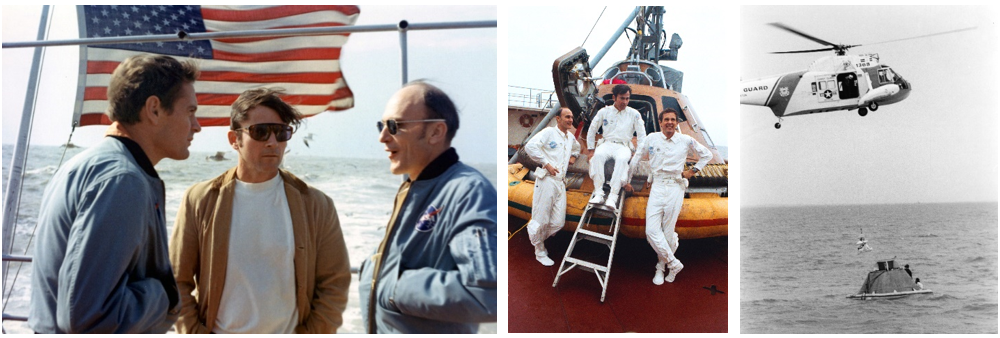
Left: Apollo 16 astronauts Charles M. Duke, left, John W. Young, and Thomas K. Mattingly aboard the Motorized Vessel Retriever prior to water-egress training. Middle: Mattingly, left, Young, and Duke pose in front of the boilerplate Apollo spacecraft prior to the water-egress training. Right: The Apollo 16 crew during water-egress training in the Gulf of Mexico. Credits: NASA
Like previous crews, the Apollo 16 astronauts conducted splashdown recovery training in the Gulf of Mexico using the Motorized Vessel Retriever. On Jan. 22, the backup crew of Haise, Roosa, and Mitchell climbed aboard a training version of an Apollo Command Module that Retriever’s sailors lowered into the water. The astronauts practiced exiting from the capsule and onto life rafts. One by one, the astronauts climbed aboard Billy Pugh nets, and crews aboard a hovering Coast Guard helicopter hoisted them aboard. Young, Mattingly, and Duke completed their egress training on Feb. 5.
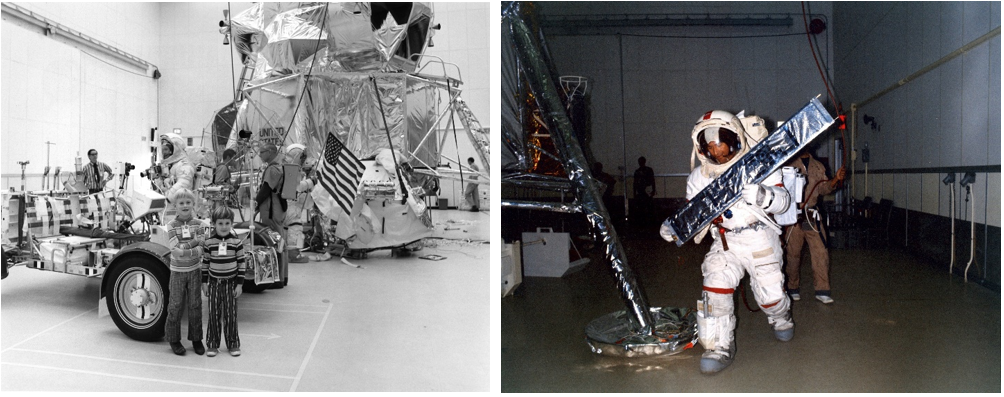
Left: Apollo 16 astronauts Charles M. Duke, left, and John W. Young train for a lunar surface spacewalk as Duke’s sons Charles, left, and Tom pose in front of the Lunar Roving Vehicle. Right: Young trains with the Cosmic Ray Detector, one of the seven experiments deployed on the lunar surface during Apollo 16. Credits: NASA
Young and Duke, and backups Haise and Mitchell, rehearsed the lunar-surface activities, including driving the LRV at Kennedy. The training involved deploying the instruments of the Apollo Lunar Surface Experiment Package and other science experiments, the astronauts communicating with controllers and scientists in the MCC at MSC as they would during the actual mission.
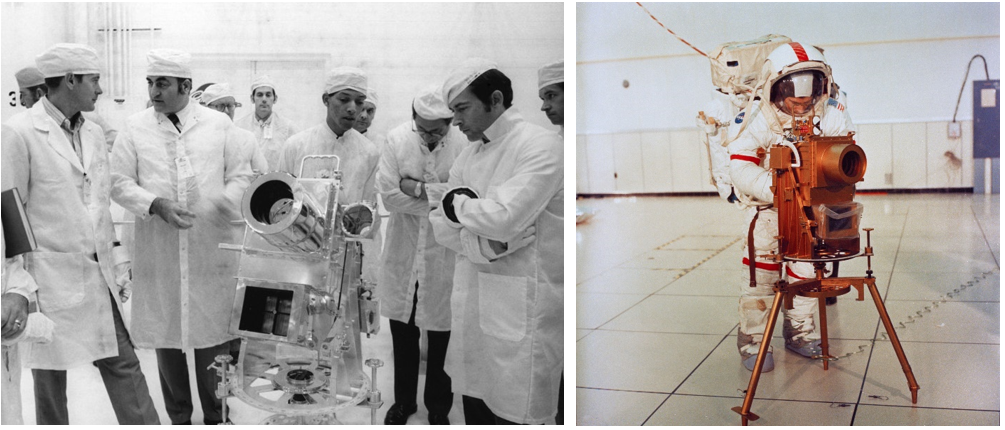
Left: Principal investigator George R. Carruthers of the Naval Research Laboratory, center, describes his Far Ultraviolet Camera/Spectrograph to Apollo 16 astronaut John W. Young, right, as fellow crew member Charles M. Duke, left, talks with Apollo Program Director Rocco A. Petrone. Right: Young practices deploying the camera using a training model. Credits: NASA
One of the instruments the Apollo 16 astronauts deployed on the lunar surface was the Far Ultraviolet Camera/Spectrograph, the first observatory set up on the Moon. George R. Carruthers of the U.S. Naval Research Laboratory in Washington, D.C., developed the instrument and became the first African American scientist to have an experiment placed on the lunar surface. In 1970, prior to his Apollo 16 experience, Carruthers was the first scientist to detect molecular hydrogen in interstellar space. During Apollo 16, his spectrograph captured the first images of Earth in the far-ultraviolet part of the spectrum from a lunar distance and also observed more than 550 stars, galaxies, and nebulae. Carruthers earned NASA’s Exceptional Scientific Achievement Medal for his work on the project. In 1991, he flew a far-ultraviolet instrument aboard the space shuttle during the STS-39 mission and, in 2012, a similar instrument aboard the Advanced Research and Global Observation Satellite for the Department of Defense. In 2013, President Barack H. Obama awarded Carruthers the National Medal of Technology and Innovation during a White House ceremony.
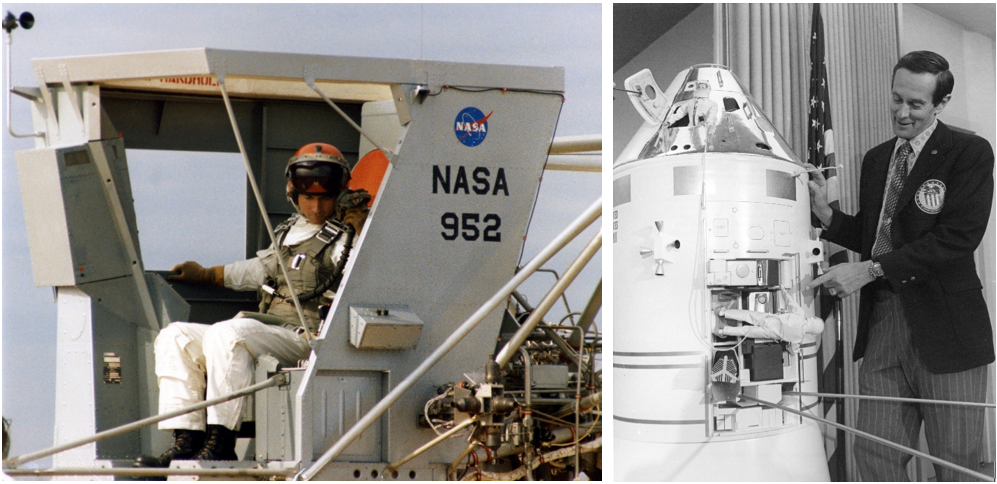
Left: Apollo 16 astronaut John W. Young trains for the descent to the Moon’s surface in the Lunar Landing Training Vehicle at Ellington Air Force Base. Right: During a press conference, Apollo 16 astronaut Charles M. Duke uses a model of the Apollo spacecraft to demonstrate how he will assist fellow crew member Thomas K. Mattingly during a deep-space spacewalk to retrieve film canisters from the Scientific Instrument Module bay. Credits: NASA
Both Young and his backup Haise practiced the descent and landing on the Moon flying the Lunar Landing Training Vehicle (LLTV) at Ellington Air Force Base near the MSC in Houston. The LLTV simulated the flying characteristics of the Lunar Module during the final several hundred feet of the descent. In MSC’s Water Immersion Facility, Mattingly and his backup Roosa practiced the deep-space spacewalk to retrieve film cassettes from the Scientific Instrument Module bay instruments in the Service Module. During a Feb. 22 press conference at NASA’s Headquarters in Washington, D.C., Duke described how he planned to support Mattingly from the open hatch of the Command Module. Mattingly and Duke practiced the spacewalk by flying aboard a KC-135 aircraft that provided brief periods of weightlessness.
To be continued …
World events in February 1972
- Feb. 1 – The first commercial handheld scientific calculator, the HP-35, is released by Hewlett-Packard, selling for $395.
- Feb. 1 – Neil Young releases his fourth album, “Harvest.”
- Feb. 3 – The 11th winter Olympic games open in Sapporo, Japan — the first to be held in Asia.
- Feb. 5 – U.S. airlines begin mandatory inspection of passengers and luggage.
- Feb. 16 – Wilt Chamberlain of the Los Angeles Lakers becomes the first NBA player to reach 30,000 career points.
- Feb. 17 – The British Parliament votes to join the European Common Market.
- Feb. 21 – Richard M. Nixon becomes the first U.S. president to visit the People’s Republic of China.







